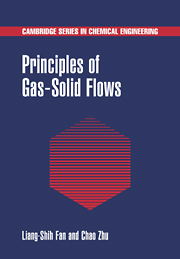Book contents
- Frontmatter
- Contents
- Preface
- Part I Basic Relationships
- 1 Size and Properties of Particles
- 2 Collision Mechanics of Solids
- 3 Momentum Transfer and Charge Transfer
- 4 Basic Heat and Mass Transfer
- 5 Basic Equations
- 6 Intrinsic Phenomena in a Gas–Solid Flow
- Part II System Characteristics
- Appendix: Summary of Scalar, Vector, and Tensor Notation
- Index
6 - Intrinsic Phenomena in a Gas–Solid Flow
from Part I - Basic Relationships
Published online by Cambridge University Press: 27 October 2009
- Frontmatter
- Contents
- Preface
- Part I Basic Relationships
- 1 Size and Properties of Particles
- 2 Collision Mechanics of Solids
- 3 Momentum Transfer and Charge Transfer
- 4 Basic Heat and Mass Transfer
- 5 Basic Equations
- 6 Intrinsic Phenomena in a Gas–Solid Flow
- Part II System Characteristics
- Appendix: Summary of Scalar, Vector, and Tensor Notation
- Index
Summary
Introduction
There are inherent phenomena associated with gas–solid flows. Such phenomena are of considerable interest to a wide spectrum of process applications involving gas–solid flows and can be exemplified by erosion, attrition, pressure-wave propagation, flow instability, and gas–solid turbulence modulation.
Mechanical erosion may cause severe damage to a pipe wall or any moving part in a gas–solid system. Particle attrition yields fine particles, which may alter the flow conditions of the system and may become a source of particulate emission. Understanding the basic modes of mechanical wear and the mechanism of attrition is essential to the control of their behavior. Pressure waves through a gas–solid suspension are directly related to nozzle flows (such as in jet combustion) and measurement techniques associated with acoustic waves and shock waves. Understanding the propagation of the speed of sound and normal shock waves in a dilute gas–solid suspension is, therefore, important. Flow instability such as wavelike motion represents an intrinsic feature of a gas–solid flow. An instability analysis can be made using the pseudocontinuum approach. For most gas–solid flows, particles move in a strong turbulent gas stream. The gas turbulence can be significantly modulated by the solid particles. Thus, understanding the particle-turbulence interactive phenomenon is necessary.
This chapter addresses the various phenomena indicated. In addition, the thermodynamic laws governing physical properties of the gas–solid mixture such as density, pressure, internal energy, and specific heat are introduced.
- Type
- Chapter
- Information
- Principles of Gas-Solid Flows , pp. 244 - 294Publisher: Cambridge University PressPrint publication year: 1998



